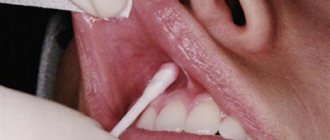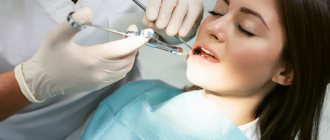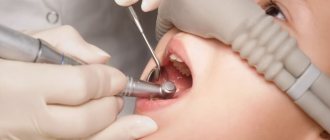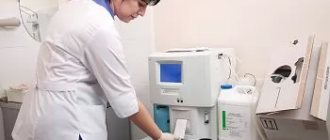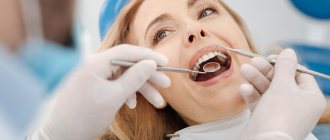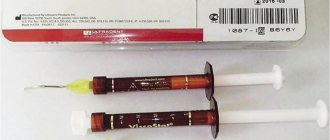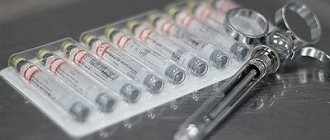The choice of the type of anesthesia for a child is made after a thorough history taking. Dentists should identify possible contraindications to the use of a particular method or pain medication. The risk group includes children with a tendency to allergic reactions.
Most often, topical anesthesia is used as local anesthesia. An anesthetic is applied to the surface of the tissues adjacent to the diseased tooth, which blocks the receptors and terminal sections of nerve fibers in the periphery. Sensitivity is turned off in the surface layers and does not affect the deep ones.
Application anesthesia is also used in other cases:
- if the patient exhibits a pronounced gag reflex during tooth preparation;
- when it is necessary to obtain intraoral X-rays or impressions of the jaw;
- to relieve pain in the marginal periodontium;
- in case of difficult eruption of wisdom teeth - for the period of excision of the hood above them;
- during a biopsy;
- during dissection of the frenulum;
- when performing curettage of periodontal pockets;
- in the treatment of minor destruction of tooth enamel, etc.
Local anesthesia
Local anesthesia is used more often in dentistry. Unlike general anesthesia, it does not have a negative effect on the general condition of a person and is not accompanied by loss of consciousness and a recovery period.
In dentistry, the injection method of local sedation is predominantly used. It involves loss of sensitivity locally, in the area of the oral cavity that the dentist plans to work with. The technique of local anesthesia can be direct or indirect. The first option is used primarily in the treatment of dental canals and gums, when a specialist injects an anesthetic at once, and the second option is used when removing teeth (layer-by-layer distribution of the anesthetic). Indirect anesthesia can significantly increase the area of sensory loss.
How is topical anesthesia performed?
The area of the mucous membrane is dried with a cotton swab. Then a small amount of anesthetic is carefully applied to it with a cotton swab or swab. The drug instantly penetrates 2-3 mm deep - the effect occurs within 30-40 seconds in the case of solutions and after 2 minutes if ointments or gel are used. The anesthesia lasts for 10-15 minutes.
As anesthetic agents in pediatric dentistry, those that meet certain requirements are used:
- soluble in water and isotonic solution;
- demonstrate high resistance to sterilization and stability in solutions;
- have a bactericidal effect and a pleasant taste, which is important for children;
- penetrate well through the epithelial layer;
- provide rapid pain relief;
- do not cause irritation;
- exhibit minimal toxicity upon absorption;
- give a minimum of adverse reactions.
No pain – anesthesia in modern dentistry
General dentist Lelekov Alexander Mikhailovich tells.
Dentists don't like to hurt. Civilized dentistry strives for complete painlessness at all stages of treatment.
The most unpleasant procedures, such as treatment of deep caries and pulpitis, tooth extraction, are unthinkable without effective anesthesia.
There are many everyday myths and outdated ideas associated with anesthesia. I’ll tell you more about this useful tool, which makes treatment comfortable, without suffering, pain and tears.
Why is it painful to be treated in some clinics, but not in others?
The patient’s sensations depend on many factors, but the most important is the anesthetic drug itself. At the beginning of the twentieth century, dentists began to use novocaine, and from the middle of the century - the more powerful lidocaine. At one time, this was a real breakthrough in medicine. The treatment became tolerable, but the pain could not be completely eliminated.
Modern clinics use anesthetics based on articaine.
Before treatment, be sure to ask what drug is used to relieve pain:
- Based on articaine, it shouldn’t hurt.
- Lidocaine, novocaine - most likely get ready for a test of patience.
For comfortable and safe treatment of my patients, I use:
- Articaine Inibsa (Spain),
- Ultracaine Sanofi (France),
- Scandonest Septodont (France).
I use Articaine in most situations. Ultracaine D, Scandonest, which do not contain adrenaline - if the patient has health problems. They can be used in elderly people, patients with diabetes mellitus, hypertension, cardiovascular diseases, and bronchial asthma. The listed anesthetics do not penetrate the placental barrier and are approved for pregnant women.
Do anesthetics contain adrenaline?
Many patients are afraid that they will be injected with adrenaline along with the anesthetic. Adrenaline (epinephrine), indeed, is contained in anesthetics; dentists value it for its vasoconstrictor effect:
- The removal of anesthetic from tissues is slowed down, so the anesthesia lasts longer.
- Bleeding is reduced, which is important when removing a tooth, treating gums or caries in the gingival area of the tooth.
But there are also undesirable effects: adrenaline can increase your heart rate and increase your blood pressure. A healthy person, as a rule, does not even notice this. But for children and patients with cardiovascular diseases, drugs with adrenaline are contraindicated.
They are given an anesthetic with reduced or no adrenaline. Earlier I mentioned the drugs Scandonest and Ultracain D - they do not contain adrenaline at all.
A mosquito is about to bite
Whether the injection will be unpleasant depends on several factors:
- Which tooth are we treating: anesthesia can be very sensitive when placed in the area of the upper and lower incisors. Mandibular anesthesia is unpleasant: an injection into the area of the mandibular nerve.
- Doctor's manual skills. If the doctor has “trained his hand” properly, is not in a hurry and has set himself the goal of making the treatment as pleasant as possible for the patient, then the injection may not be felt at all.
- The equipment of the clinic: for the patient’s comfort, thin needles and special carpule syringes were invented. For children, topical anesthesia is used - the gel is applied to the gum and “freezes” it before the injection.
Carpule syringe
You may have noticed the unusual but recognizable shape of an anesthesia syringe. It has rings on the sides to make it fit more comfortably in the doctor's hand.
But the main thing about it is a mechanism that allows you to carry out anesthesia quickly, effectively and safely in absolutely sterile conditions. The capsule with the drug is opened by this mechanism right inside the syringe. Fewer hands means fewer germs.
The needles for the carpule syringe are thin and flexible, they are easy to bend at the desired angle. With them you can get close to awkwardly located teeth and provide pain relief in the best possible way.
If anesthesia is contraindicated
In most cases, anesthesia is not completely contraindicated, but only requires a more careful, balanced approach. The doctor takes into account the patient’s age, health characteristics and selects the optimal drug and dosage.
Be sure to tell your doctor if you have the following diseases:
- Heart diseases: arrhythmia and tachycardia, previous heart attacks and heart surgery.
- High blood pressure.
- Problems with the endocrine system: diabetes and thyroid lesions.
- Glaucoma.
- Liver failure.
- Psychoneurological diseases, including epilepsy.
- Individual intolerance to the components of the drug.
Allergy to local anesthetics deserves special attention. If you have ever had an allergic reaction to an anesthetic, be sure to remember its name.
In diagnostic laboratories you can order an allergy panel - an analysis of the body's reactions to various drugs. This way you will find the anesthetic approved for you. There is no need to buy it or bring it to your appointment! When making an appointment with a dentist or for a consultation, check whether the clinic can purchase the required anesthetic for you.
General anesthesia
If it is impossible to use any local anesthetic, we will not torment the patient with pain anyway. In such cases, anesthesia is used - dental treatment during sleep.
The procedure is carried out under the supervision of an anesthesiologist-resuscitator, who monitors the patient’s condition using special equipment.
To make the anesthesia work better
A few tips for maximum pain relief:
- Don’t be nervous before your appointment; you can take a mild sedative;
- Do not drink alcohol or liters of coffee, they can reduce the effectiveness of anesthesia;
- Don't delay treatment. If pus forms near the tooth, it will prevent the anesthetic from working.
High-quality anesthesia is not only about the comfort and peace of mind of the doctor and the patient.
Most patients who are afraid of dental treatment are actually afraid of the pain, not the treatment itself. And the fear goes away when they come to the clinic, where reliable pain relief is used.
Having got used to good anesthesia, the patient does not delay treatment and keeps his teeth healthy!
What drugs are used for topical anesthesia?
In pediatric dentistry, solutions, emulsions, ointments, pastes, gels, aerosols are used, as well as special dispersed tablets, caramels and children's chewing gum. They contain highly concentrated anesthetics without vasoconstrictors. Most often, dentists use solutions, sprays and aerosols.
- "Babident" is intended for pain relief during the eruption of primary teeth in infants. Apply 1-2 drops of the solution with a cotton swab or finger to the mucous membrane of the gums 1-3 times a day.
- In pediatric dentistry, Perylene-Ultra solution is often used.
- The most popular gels and pastes are “Xylonor”, “Instilagel”, “Aroma paste carried”, Jen-Dental, Xyligel.
- The most commonly used ointments are 2-3% dicaine, 5% lidocaine, 2-3% falicaine, etc.
Non-injection anesthesia
Non-injection anesthesia involves the use of local agents that are in the form of an aerosol or gel. They are used for initial pain relief. In some cases where short-term dental treatment is required, non-injection sedation methods can be used as applications that are applied to a limited area of tissue.
Non-injection anesthesia in dentistry can be of the following types:
- electronarcosis;
- superficial or terminal anesthesia;
- refrigeration or freezing.
The specific type of anesthesia is selected by the dentist after a personal consultation, studying the patient's medical history, his general health and many other factors.
Particular attention when choosing an anesthesia option and a specific drug is required in the presence of chronic diseases affecting the cardiovascular system, kidneys, liver and respiratory organs. It is also important to minimize the risks of severe allergic reactions in people suffering from allergic pathologies (bronchial asthma, skin diseases).
Spray irrigation method
According to the results of clinical studies, the most pronounced analgesic effect in the treatment of caries of temporary teeth is provided by sprays and aerosols, for example Lignospam, Lidokain 10%, Legekain, etc. Anesthesia occurs after 30-40 seconds and lasts for 15 minutes. Due to their unpleasant taste, gels and aerosols are contraindicated in children under four years of age, as they increase salivation and can enter the respiratory tract and cause respiratory arrest.
Older children also complain of local symptoms after irrigation - numbness of the laryngeal tissue, sensation of a lump in the throat, hoarseness, which sometimes lead to breathing problems. Therefore, before using sprays and aerosols, the dentist must tell the patient how to behave correctly and make sure that he has accepted the information. This type of anesthesia can only be done while exhaling, but it is safer to apply the product to a cotton swab and apply it to the area, similar to liquid solutions.
"Freeze"
What is “freezing” and why does it “freeze”? Many of us are mistaken in thinking that it's all about temperature. The loss of sensation as a result of cooling is fundamentally different from anesthesia, which is carried out using an injection with an anesthetic. As such, toothache does not disappear anywhere, but the nerve impulse that transmits the signal about its occurrence to the brain is blocked by an anesthetic. Once in the tissue, the anesthetic deprives the nerve of the ability to conduct pain impulses, changing its electrical potential. The nerve acquires the ability to conduct impulses again after the anesthetic leaves the body, breaking down under the action of special enzymes. The effectiveness and duration of anesthesia directly depends on the correctly selected type of anesthetic, its dose and method of application.
I would also like to note that today anesthesia is carried out not only before the process of “tooth drilling”, but also for the anesthesia manipulation itself! To do this, the planned injection site is “frozen” using a special anesthetic gel, after which the introduction of the needle and the drug becomes absolutely painless.
Features of tooth extraction in pregnant women
Tooth extraction is considered a major surgical procedure. If such an operation is necessary, only high-quality drugs should be used for pain relief. Tooth extraction in pregnant women is carried out only for serious indications, when other treatment methods do not give the desired result.
Removing wisdom teeth has its own characteristics. This operation is more complex and difficult for the body to tolerate. Very often, to prevent wound infection, the patient is prescribed antibiotics, which is unacceptable during pregnancy.
When are dental procedures acceptable?
Some experts believe that during pregnancy it is better to refuse any health-related interventions, because this period is characterized by serious changes both in the endocrine system and in the entire body as a whole. Surgery can be a real test for the mother and significantly affect the health of the fetus.
In the first trimester of pregnancy, a woman should be attentive to herself, since during this period all the vital organs of the baby are formed. The health of the baby for the rest of his life depends on how correct the mother’s lifestyle is. That is why you should be careful when taking medications that have a strong effect, including anesthetic.
In later stages of pregnancy, care should be taken to ensure the safety of the fetus. In the last trimester, any severe stress can cause serious complications, including premature birth. Incorrectly selected anesthesia and fear of surgery can seriously harm the baby’s health.
In the second trimester, pregnancy is more stable. There are much fewer dangers to the baby’s health than at the beginning or end of pregnancy. That is why experts consider this period the most favorable for seeking dental care. For a period of 4-6 months, it is permissible to use certain medications during dental treatment. Most procedures will be well tolerated by the woman’s body and will not affect the development of the child.
In any case, before going to the dentist, you should consult with your doctor who is managing your pregnancy. He will tell you about all the dangers that can await a woman when using this or that drug. In addition, it is imperative to inform your dentist about your exact gestational age, who will select the appropriate treatment regimen depending on all the individual characteristics of the body.
Drugs used
Anesthesia in dentistry requires the use of fast-acting anesthetics. It is important to achieve “freezing” of tissues to a certain depth and for a specific period of time.
Preparations for pain relief in dentistry:
- Mepivazestine - characterized by rapid loss of sensitivity, can be used in pediatric dentistry (from 4 years and older);
- Septanest is an affordable anesthetic that can cause allergic reactions due to the presence of sodium sulfate in the composition;
- Ultracaine is the most common drug for anesthesia in dentistry; it is highly effective and has different dosages;
- Scandonest is a modern generation anesthetic that has a low risk of allergic reactions and other complications;
- Bizestin is an analogue of the frequently used drug Ultracain, and has a lower cost in comparison with it.
Anesthesia for dental treatment
Many women are interested in the question: is it possible to freeze a tooth during pregnancy? The answer to this question is ambiguous. Some obstetricians and gynecologists have a negative attitude towards any type of painkillers. Other experts believe that pain should not be tolerated as it can cause serious stress and affect the health of the fetus.
In any case, you should trust your doctor. Local anesthesia is considered the safest in terms of influence on the intrauterine development of the child. Drugs must be of high quality and have all certificates confirming the safety of the drug. You should also pay attention to the expiration date of the anesthetic. If any suspicions arise, it is better to refuse the help of a doctor and go to another clinic.
Properly done freezing a tooth during pregnancy does not in any way affect the health of the fetus or the duration of its gestation. Modern drugs do not allow the active substances to penetrate the placenta to the baby. Therefore, you can not be afraid and feel free to treat your teeth.
